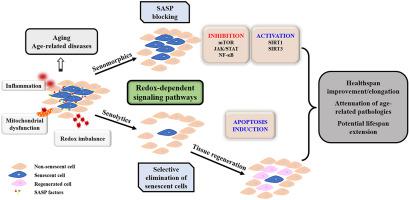细胞衰老是受遗传,表观遗传和环境因素指导的异质过程,其特征是多种类型的体细胞。有人认为它是衰老的标志,被认为会导致衰老和慢性疾病。衰老细胞(SC)表现出特定的衰老相关分泌表型(SASP),其主要特征在于促炎分子和基质降解分子的产生。当SC积累时,会引起慢性,全身性,低度炎症,称为发炎。反过来,这种慢性免疫系统的激活导致SC清除率降低,从而建立了加剧炎症的恶性循环。SC积累代表各种与年龄相关的病理的病因。已经提出了针对多个老化标志的建议,以作为改善健康期甚至寿命的一种策略。因此,通过天然或合成化合物的选择性杀伤SC或选择性的SASP阻断,SC和SASP被视为潜在的治疗靶标。这些化合物是被称为感觉治疗剂的药物家族的成员,分为麻醉疗法和麻醉疗法。它们中的很少有人已经在临床试验中,可能代表了与年龄相关的病理学的未来治疗方法,包括动脉粥样硬化,骨关节炎,骨质疏松,癌症,糖尿病,神经退行性疾病(例如阿尔茨海默氏病),心血管疾病,肝脂肪变性,慢性阻塞性肺疾病等疾病,特发性肺纤维化和与年龄有关的黄斑变性。在这篇评论中,我们介绍了已经确定的senolytics和senomorphics,重点是它们对氧化还原的敏感特性。我们描述的研究揭示了它们对细胞衰老的影响,并使它们被提名为新型抗衰老剂。我们指的是已经在临床试验中使用的senolytics,目前为止,我们介绍了各种治疗药物所表现出的各种不良反应。最后,我们讨论了需要改进的化疗药物的各个方面,并建议针对未来特定于氧化还原调节的信号通路(涉及SASP的调节或SC的消除)的未来疗法的设计。我们指的是已经在临床试验中使用的senolytics,目前为止,我们介绍了各种治疗药物所表现出的各种不良反应。最后,我们讨论了需要改进的化疗药物的各个方面,并建议针对未来特定于氧化还原调节的信号通路(涉及SASP的调节或SC的消除)的未来疗法的设计。我们指的是已经在临床试验中使用的senolytics,目前为止,我们介绍了各种治疗药物所表现出的各种不良反应。最后,我们讨论了需要改进的化疗药物的各个方面,并建议针对未来特定于氧化还原调节的信号通路(涉及SASP的调节或SC的消除)的未来疗法的设计。
 "点击查看英文标题和摘要"
"点击查看英文标题和摘要"
Senolytics and senomorphics: Natural and synthetic therapeutics in the treatment of aging and chronic diseases
Cellular senescence is a heterogeneous process guided by genetic, epigenetic and environmental factors, characterizing many types of somatic cells. It has been suggested as an aging hallmark that is believed to contribute to aging and chronic diseases. Senescent cells (SC) exhibit a specific senescence-associated secretory phenotype (SASP), mainly characterized by the production of proinflammatory and matrix-degrading molecules. When SC accumulate, a chronic, systemic, low-grade inflammation, known as inflammaging, is induced. In turn, this chronic immune system activation results in reduced SC clearance thus establishing a vicious circle that fuels inflammaging. SC accumulation represents a causal factor for various age-related pathologies. Targeting of several aging hallmarks has been suggested as a strategy to ameliorate healthspan and possibly lifespan. Consequently, SC and SASP are viewed as potential therapeutic targets either through the selective killing of SC or the selective SASP blockage, through natural or synthetic compounds. These compounds are members of a family of agents called senotherapeutics divided into senolytics and senomorphics. Few of them are already in clinical trials, possibly representing a future treatment of age-related pathologies including diseases such as atherosclerosis, osteoarthritis, osteoporosis, cancer, diabetes, neurodegenerative diseases such as Alzheimer’s disease, cardiovascular diseases, hepatic steatosis, chronic obstructive pulmonary disease, idiopathic pulmonary fibrosis and age-related macular degeneration. In this review, we present the already identified senolytics and senomorphics focusing on their redox-sensitive properties. We describe the studies that revealed their effects on cellular senescence and enabled their nomination as novel anti-aging agents. We refer to the senolytics that are already in clinical trials and we present various adverse effects exhibited by senotherapeutics so far. Finally, we discuss aspects of the senotherapeutics that need improvement and we suggest the design of future senotherapeutics to target specific redox-regulated signaling pathways implicated either in the regulation of SASP or in the elimination of SC.



































 京公网安备 11010802027423号
京公网安备 11010802027423号